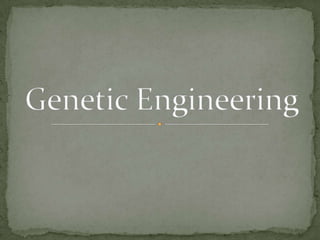Introduction to Genetic Engineering
•Descargar como PPTX, PDF•
12 recomendaciones•24,089 vistas
An introduction to genetic engineering powerpoint that I used in my 8th grade field placement
Denunciar
Compartir
Denunciar
Compartir

Recomendados
Más contenido relacionado
La actualidad más candente
La actualidad más candente (20)
Mechanisms of Evolution: Population Selection and Change

Mechanisms of Evolution: Population Selection and Change
Similar a Introduction to Genetic Engineering
Similar a Introduction to Genetic Engineering (20)
Biology - Chp 13 - Genetic Engineering - PowerPoint

Biology - Chp 13 - Genetic Engineering - PowerPoint
How is Genetic Information Passed on from the.pptx

How is Genetic Information Passed on from the.pptx
Animal Cloning Procedure, Problems and Perspectives

Animal Cloning Procedure, Problems and Perspectives
Último
Último (20)
Strategize a Smooth Tenant-to-tenant Migration and Copilot Takeoff

Strategize a Smooth Tenant-to-tenant Migration and Copilot Takeoff
Bajaj Allianz Life Insurance Company - Insurer Innovation Award 2024

Bajaj Allianz Life Insurance Company - Insurer Innovation Award 2024
The 7 Things I Know About Cyber Security After 25 Years | April 2024

The 7 Things I Know About Cyber Security After 25 Years | April 2024
[2024]Digital Global Overview Report 2024 Meltwater.pdf![[2024]Digital Global Overview Report 2024 Meltwater.pdf](data:image/gif;base64,R0lGODlhAQABAIAAAAAAAP///yH5BAEAAAAALAAAAAABAAEAAAIBRAA7)
![[2024]Digital Global Overview Report 2024 Meltwater.pdf](data:image/gif;base64,R0lGODlhAQABAIAAAAAAAP///yH5BAEAAAAALAAAAAABAAEAAAIBRAA7)
[2024]Digital Global Overview Report 2024 Meltwater.pdf
Apidays Singapore 2024 - Building Digital Trust in a Digital Economy by Veron...

Apidays Singapore 2024 - Building Digital Trust in a Digital Economy by Veron...
Scaling API-first – The story of a global engineering organization

Scaling API-first – The story of a global engineering organization
08448380779 Call Girls In Diplomatic Enclave Women Seeking Men

08448380779 Call Girls In Diplomatic Enclave Women Seeking Men
Handwritten Text Recognition for manuscripts and early printed texts

Handwritten Text Recognition for manuscripts and early printed texts
Axa Assurance Maroc - Insurer Innovation Award 2024

Axa Assurance Maroc - Insurer Innovation Award 2024
Strategies for Unlocking Knowledge Management in Microsoft 365 in the Copilot...

Strategies for Unlocking Knowledge Management in Microsoft 365 in the Copilot...
Powerful Google developer tools for immediate impact! (2023-24 C)

Powerful Google developer tools for immediate impact! (2023-24 C)
Introduction to Genetic Engineering
- 2. It is the direct manipulation of an organism’s genome using modern DNA technology … also called genetic modification A genome is the entirety of an organism’s hereditary information
- 3. Glow-in-the-dark cats Venomous cabbage Web-spinning goats Less flatulent cows
- 4. Scientists have recently taken the gene that programs poison in scorpion tails and looked for ways to combine it with cabbage. This would limit pesticide use while still preventing caterpillars from damaging cabbage crops. These genetically modified cabbages would produce scorpion poison that kills caterpillars when they bite leaves — but the toxin is modified so it isn’t harmful to humans.
- 5. Agriculture research scientists at the University of Alberta have identified the bacterium responsible for producing methane and designed a line of cattle that creates 25 percent less methane than the average cow.
- 6. Researchers inserted a spiders’ dragline silk gene into the goats’ DNA in such a way that the goats would make the silk protein only in their milk. This “silk milk” could then be used to manufacture a web- like material called Biosteel.
- 7. In 2007, South Korean scientists altered a cat’s DNA to make it glow in the dark and then took that DNA and cloned other cats from it — creating a set of fluffy, fluorescent felines. The researchers took skin cells from Turkish Angora female cats and used a virus to insert genetic instructions for making red fluorescent protein.
- 10. The term cloning describes a number of different processes that can be used to produce genetically identical copies of a biological entity. The copied material, which has the same genetic makeup as the original, is referred to as a clone. They occur naturally and artificially
- 11. Gene Cloning: produces copies of genes or segments of DNA Reproductive Cloning: produces copies of whole animals Therapeutic Cloning: produces embryonic stem cells for experiments aimed at creating tissues to replace injured or diseased tissues
- 12. The procedure consists of inserting a gene from one organism, often referred to as "foreign DNA," into the genetic material of a carrier called a vector. Examples of vectors include bacteria, yeast cells, and viruses. After the gene is inserted, the vector is placed in laboratory conditions that prompt it to multiply, resulting in the gene being copied many times over.
- 13. Remove DNA from an egg cell Replace with DNA from the animal you wish to clone by injection or electrical current Allow egg to develop into an early-stage embryo Finally, implant into the womb of a female of the animal you are trying to clone
- 14. Could create genetically modified animals (sheep that produce milk that contains blood clotting protein) Create animals for food Bring back extinct species …. DINOSAURS!!!
- 15. Very inefficient … the cloned sheep Dolly was the only embryo out of 277 that actually survived Numerous health issues including early death Minimal genetic variability
- 16. Therapeutic cloning involves creating a cloned embryo for the sole purpose of producing embryonic stem cells with the same DNA as the donor cell. One of the human body's master cells, with the ability to grow into any one of the body's more than 200 cell types The best stem cells exist during the first five days of embryo The cells are harvested resulting in destruction of the embryo
- 17. Applications Stem cells can be used in experiments to help understand disease and create new treatments New tissue formation Drawbacks Stem cells are similar to cancer cells in that they can reproduce indefinitely and could develop mutations It involves killing an embryo
- 19. Read the articles on cloning Choose your side Write a paragraph explaining why you chose that side
